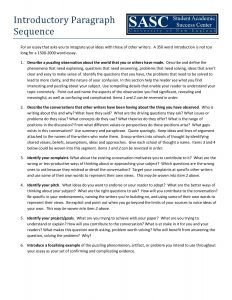Not sure how to get your essay started? Consider making these moves.
 Describe a puzzling observation about the world that you or others have made. Describe and define the phenomena that need explaining, questions that need answering, problems that need solving, ideas that aren’t clear and easy to make sense of. Identify the questions that you have, the problems that need to be solved to lead to more clarity, and the nature of your confusion. In this section help the reader see what you find interesting and puzzling about your subject. Use a few compelling details that enable your reader to understand your topic concretely. Point out and name the aspects of the observation you find significant, revealing and meaningful, as well as confusing and complicated. Items 1 and 2 can be reversed in order.
Describe a puzzling observation about the world that you or others have made. Describe and define the phenomena that need explaining, questions that need answering, problems that need solving, ideas that aren’t clear and easy to make sense of. Identify the questions that you have, the problems that need to be solved to lead to more clarity, and the nature of your confusion. In this section help the reader see what you find interesting and puzzling about your subject. Use a few compelling details that enable your reader to understand your topic concretely. Point out and name the aspects of the observation you find significant, revealing and meaningful, as well as confusing and complicated. Items 1 and 2 can be reversed in order.- Describe the conversations that other writers have been having about the thing you have observed. Who is writing about this and why? What have they said? What are the driving questions they ask? What issues or problems do they raise? What concepts do they use? What theories do they offer? What is the range of positions in the discussion? From what different values or perspectives do these positions arise? What gaps exists in this conversation? Use summary and paraphrase. Quote sparingly. Keep ideas and lines of argument attached to the names of the writers who make them. Group writers into schools of thought by identifying shared values, beliefs, assumptions, ideas and approaches. Give each school of thought a name. Items 3 and 4 below could be woven into this segment. Items 1 and 2 can be reversed in order.
- Identify your complaint. What about the existing conversation motivates you to contribute to it? What are the wrong or less-productive ways of thinking about or approaching your subject? Which questions are the wrong ones to ask because they mislead or derail the conversation? Target your complaints at specific other writers and use some of their own words to represent their own views. This may be woven into item 2 above.
- Identify your pitch. What ideas do you want to endorse or your reader to adopt? What are the better ways of thinking about your subject? What are the right questions to ask? How will you contribute to the conversation? Be specific in your endorsements, naming the writers you’re building on, and using some of their own words to represent their views. Be explicit and point out when you go beyond the limits of your sources to voice ideas of your own. This may be woven into item 2 above.
- Identify your project/goals. What are you trying to achieve with your paper? What are you trying to understand or explain? How will you contribute to the conversation? What is at stake in it for you and your readers? What makes this question worth asking, problem worth solving? Who will benefit from answering the question, solving the problem? Why?
- Introduce a focalizing example of the puzzling phenomenon, artifact, or problem you intend to use throughout your essay as your set of confirming and complicating evidence.
![SASC - Student Academic Success Center - UNE [logo]](https://s3.amazonaws.com/files.uneportfolio.org/wp-content/uploads/sites/5/2022/02/SASCLogoSquare_Smaller-3-e1644936452801.jpeg)
1 thought on “Introductory Paragraph Sequence”